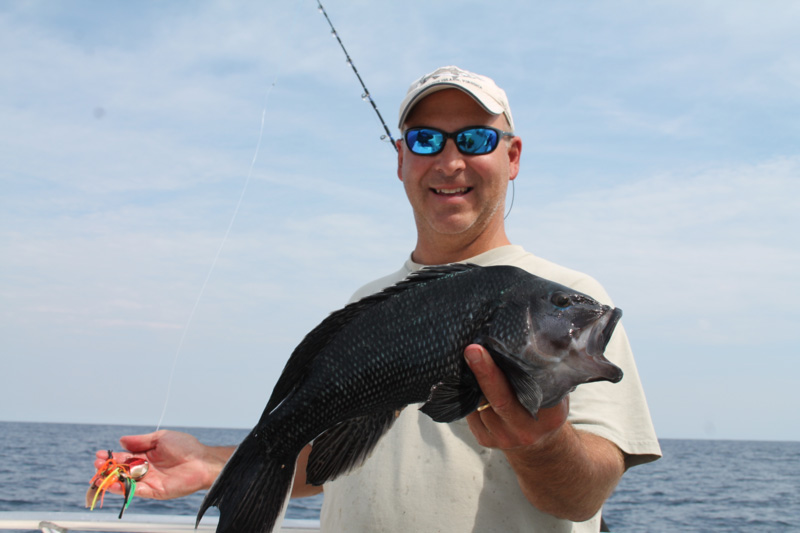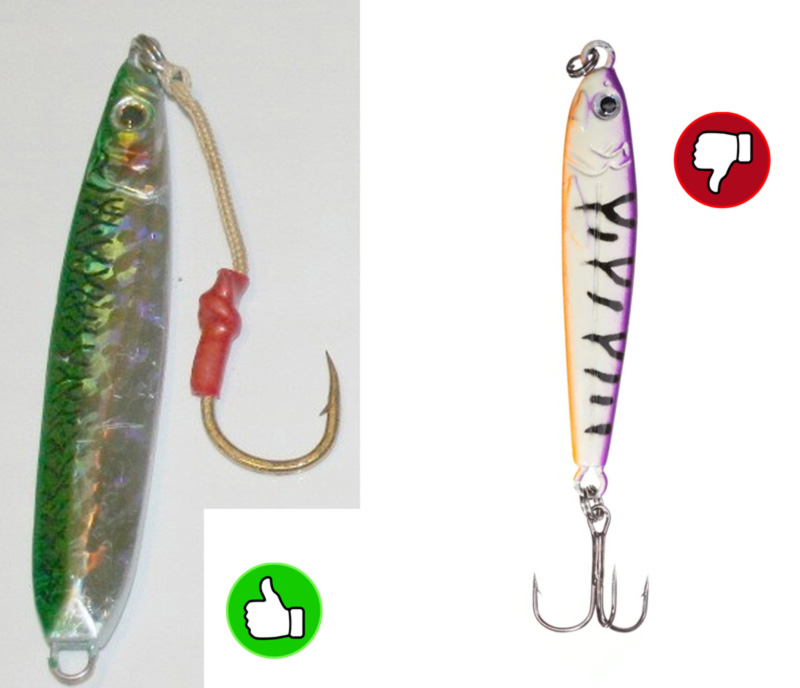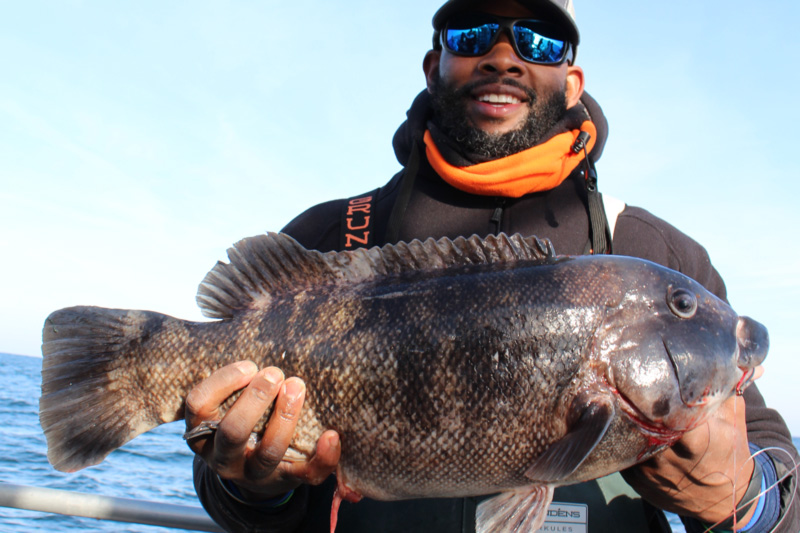Wrecks are artificial reef sites that attract fish — period — and there are plenty of Chesapeake Bay reefs as well as many found off the coast. Sure, some sites are better than others and which are hot will change with seasonal variations, but as a general rule of thumb, when you want to try bottom fishing for a mixed bag nothing beats parking your boat atop some serious structure.

Getting to the structure is, of course, only the first part of the battle.
Wreck Fishing with Bait
Once you’ve located the structure you have to fool those fish into biting, and in most cases the simplest way to do so is to drop down fresh or live bait. When fishing static (more on how to handle the boat will come up in a sec), most of the time a simple top-and-bottom rig with two hooks and a weight at the bottom will work best. Just how stout a rig you need will vary a bit depending on the target species, as will the bait of choice. Some variation in the specific rigs may also be in order. To try to make the basics as easy as possible to understand, we’ve broken it all down by species in this table.
Species Rig Size Rig Variations Best Baits
|
Medium weight; often tied with 60- to 80-pound test leader and 2/0 to 4/0 hooks. |
Many people like to add hooks with beads and spinners. |
Squid strips are the norm but sea bass are opportunistic and clam chunks, crab chunks, or fish strips can all prove effective. On some occasions, clam chunks rule. |
|
|
Small standard-issue wire rigs from the tackle shop. |
Generally speaking, none, although some people like to add hooks with beads and spinners |
Bloodworms, lugworms, Fishbites, small chunks of soft or peeler crab, squid strips. |
|
|
Medium size in the 40- to 50-pound class. |
“Fluke Killer” rigs with beads, a spinner, and a bucktail or tinsel teaser. Spin-N-Glo rigs are also effective. |
Squid, minnow, or a squid/minnow sandwich; GULP! Swimming Mullet. |
|
|
Spadefish (Found often enough above/around wrecks near the coast and lower Bay that we’ll include them here). |
Small to medium leaders of about 20-pound test. |
Rig straight to the leader and a single small #2 or #1 hook as opposed to using a bottom rig; add small split shot to get baits down as bit as necessary depending on the current. |
Cannonball jellies are best but are very difficult to come by; clam bits are the norm. |
|
Small standard-issue wire rigs from the tackle shop. Chesapeake Sabikis also work well. |
Generally speaking, none, although some people like to add hooks with beads and spinners |
Bloodworms, lugworms, or Fishbites are best. Grass shrimp or small chunks of crab or squid will work, too. |
|
|
Heavy 80-pound test mono rigs for chafe resistance and quickly horsing fish away from structure. |
Some anglers prefer a “Snauf” rig, with the weight in the middle and a hook off either side, as opposed to a standard bottom rig. |
Green crab, white crab, peeler crab, sand fleas. |
|
|
Small to medium with 20- to 30-pound test. |
Tiny #2 or even #4 hooks are necessary to match the fish’s tiny mouths. |
Tiny squid bits, fish bits, or bloodworm bits. |
|
|
Small standard-issue wire rigs from the tackle shop. Chesapeake Sabikis also work well. |
Generally speaking, none, although some people like to add hooks with beads and spinners |
Bloodworms, lugworms, Fishbites, or grass shrimp. At times grass shrimp rule. |
Of course, in addition to these there are lots of other species that can show up around wrecks and reefs. In the Chesapeake Bay rockfish may well be hugging the structure, fun critters like puffer fish could show up any time, and in southern areas cobia could be lurking nearby. Along the coast cutlassfish could provide a surprise, or an amberjack could put a sudden jolt on your line — you simply never know what will pop up at a wreck site.
Wreck Fishing With Lures
While most of the anglers in the wrecking crew will stick with bait, a few dedicated sharpies prefer to fish lures. Lures aren’t always as effective (though they certainly can be at times) but they have a couple of added advantages. First off, when fished just above the wreckage snags can be minimized as compared to bottom fishing on a wreck. Secondly, by choosing larger lures you can eliminate the hassle of tiny bait-stealers and throwbacks that are often found at wrecks and reefs.
The size, type, and weight of the lure you’ll want to choose depend to a large degree on the depths you’ll be fishing and the amount of current they’re subject to. In relatively shallow areas of 30 feet or less in the Bay you may even be able to get away with using a one-ounce jighead with a plastic tail. But in 80 or 100 feet of water off the coast, a four- or five-ounce jigging spoon will probably be a much better choice.
Note: when choosing a jigging spoon for wreck fishing, stay away from those rigged with a treble hook on the end and instead opt for the ones with a single hook swinging from the top. These will get snagged on the structure far less often and are usually no less effective at hooking the fish. In some cases, particularly for sea bass, anglers using this type of jigging spoon will add a squid strip to the hook for some added enticement.

Many wreck anglers also like to employ bucktails or double-bucktail rigs, sometimes sweetened with a bait like a squid strip. This can be particularly effective on flounder, when drifting next to a wreck or across a wider area of reef or wreck structure.
Wreck Fishing Tactics
Some wreck and reef anglers prefer to drift fish, while others want the boat to remain as static as possible. Drift fishing allows you to cover more area and relocate quickly and easily when the bite drops off, and for flounder in particular is virtually always a better bet since the flatfish tend to be scattered around the wreckage as opposed to balled up right on it. However, fishing wrecks and reefs while adrift also results in about 10 times as many snags as opposed to fishing vertically over the structure.
Anchoring over the wreckage is the preferred method of most anglers, especially those who cringe at the thought of going through a dozen rigs in a day. Judging wind and current well enough to anchor directly over a wreck can be challenging, but if you drop the anchor and the boat ends up settling over unproductive bottom, don’t just sit there and wait for a fish to swim by — yank the anchor right back up and reposition. With a large profile wreck, you may be able to drop a wreck anchor (a grappling anchor which grabs the structure but has tines that can be bent out using the boat’s power, to get it free) and sit directly over the hotspot. The best captains may drop two anchors at about 90 degrees from one another, to harness the boat in a very specific position.
Trumping either method is utilizing today’s virtual anchoring systems. This can be in the form of a bow-mounted electric trolling motor armed with GPS like a Minn Kota with Spot-Lock functionality, or via one of the outboard joystick controls like Yamaha’s Helm Master with SetPoint. In both cases, you can position your boat directly atop the structure, press a button, and hover in place with zero additional effort on your part. Just as important, however, you can press a button or nudge the joystick to alter your position in five- or 10-foot increments. This allows you to work across a wreck from stem to stern.

The ability to fine-tune the placement of your offerings also means you can move the boat as the bite slows in any specific spot — maybe because you’ve caught all the fish in that exact location. Thus, you might just be in for nonstop action all day long. And that, anglers, makes for a very happy wrecking crew.